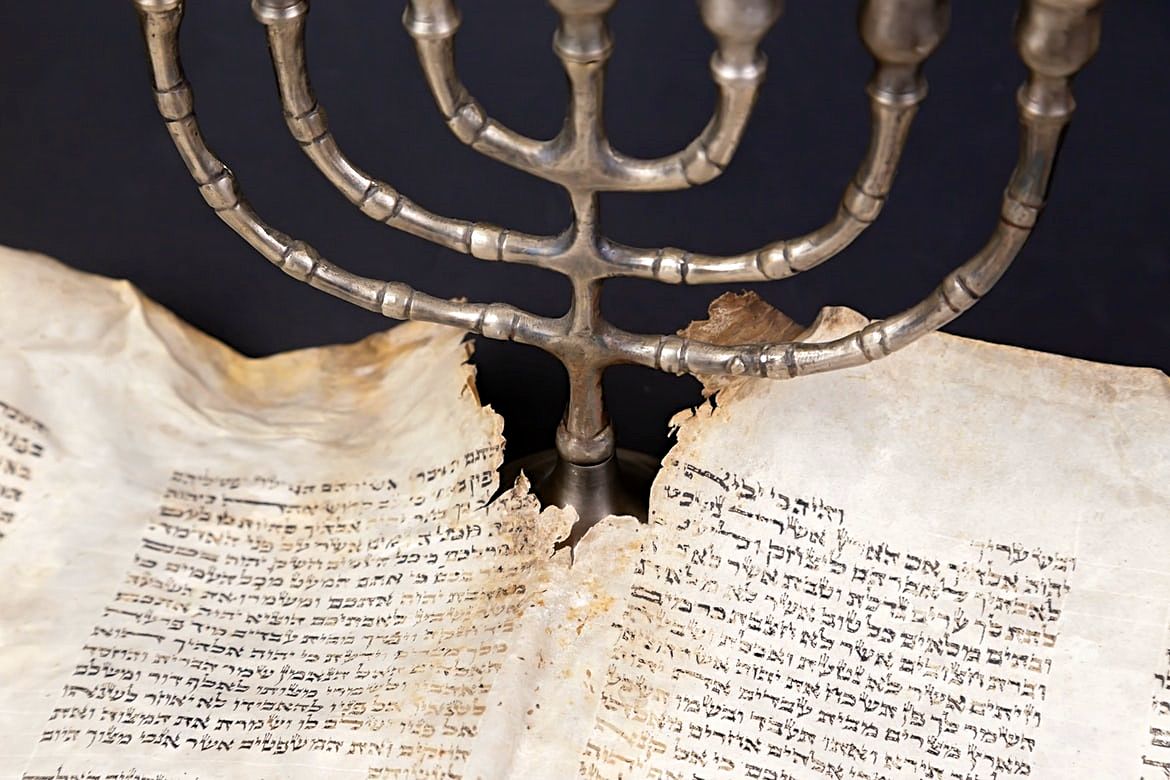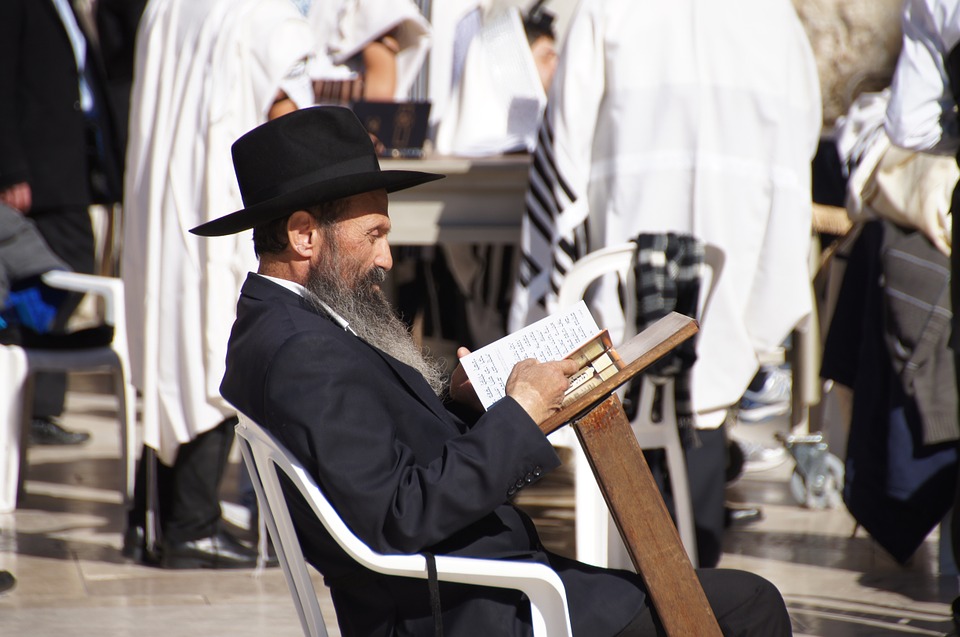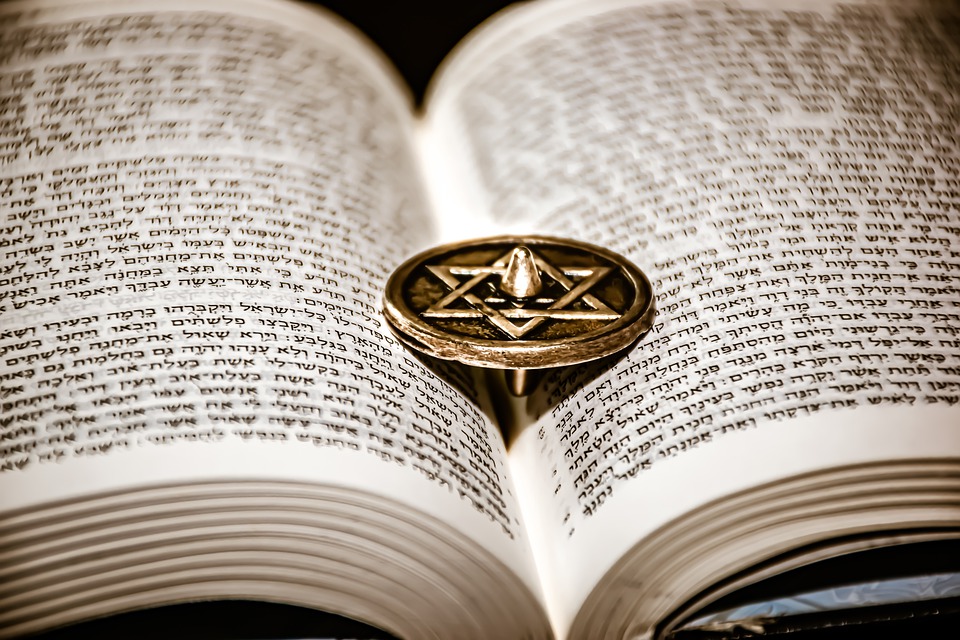Jews and their Sacred Texts
There is a famous saying that stretches back into time immemorial - that Jews are the People of the Book. This is also one of the things modern Israel is know for. Now if you ask many people why this is, they will tell you that the saying arose because Jews, historically, have been so committed to learning and reading. And of course, whilst this is surely the case, what many don’t realise is that the expression originated in the Koran - the Muslim’s holy book!

Old scrolls of the Jewish Bible and Menorah. Photo by Diana Polekhina on Unsplash
‘The People of the Book’
Today, many people associate the term with the idea that Jews have a great love of literature and prize learning above all other things. And whilst this is definitely the case (think of how many Jewish Nobel Prize winners there are, not to mention authors, screenwriters, and scholars) in its strictest sense ‘People of the Book’ refers to the Jews’ relationship with their holy books; their sacred scriptures.
What do these sacred texts contribute to Judaism?
The sacred texts of Judaism cannot be underestimated and their importance goes far beyond their religious teachings and messages. They refer not just to religion in Judaism but the long and rich history and culture of the Jewish people. Moreover, In Hebrew, there is a term ’Or Lagoyim’ which, basically translated, means ‘light unto the nations’.
Originating from the prophet Isaiah, it essentially implies that Jews have a moral and ethical obligation to behave according to the highest standards, in order to set an example. In essence, it is a way of encouraging Jews to act in a way that presents the most positive aspects of Judaism (i.e. justice, compassion, and charity).

Father and son praying at the Western Wall. Photo by Anton Mislawsky on Unsplash
Books on Jewish Customs and Traditions
In Israel itself, the majority of citizens are Jews but not all of them consider themselves religious (i.e. believers in God). Their collective outlook is wide-ranging - from secular to traditional and orthodox to ultra-orthodox. However, if you ask many secular Jews if they feel they have a connection to the scriptures, they will say yes, because whilst they do not believe every word that is written in the Bible, they still take the view that it embodies many of the historical, cultural, social and philosophical stories of the Jews over the ages.
So, yet, many traditional Jews (i.e. those who do not adhere to strict Rabbinic law but maintain an appreciation for the history and culture of Judaism) have a relationship to the Hebrew Bible. These teachings often have a deep impact on them - however secular they might feel in day-to-day life.
This is why, on the major holidays in the calendar, you will see Jews not just in Israel but across the diaspora visiting synagogues, partaking in ancient traditions, and reading from their holy Jewish books. Whatever their private belief systems, they feel bound together by something bigger than themselves, and the stories of Judaism they have learned as children are a big part of this.

Kipas for sale at a stall in Safed, Israel. Photo credit © Dmitry Mishin
The Books of the People of the Book
There are many kinds of Jewish holy books and Jewish prayer books, used by Jews at prayer in the synagogue and for study in their homes or dedicated ‘yeshivas’ (Jewish seminaries). Today we are going to look at a few of them - how they came to be written, what they mean to Jews, when (in particular) they are read, and what they offer both the scholar and the layperson, in terms of a guide to religion and life itself. Whether it is the Hebrew Bible, a specific prayer book for a holiday festival, a commentary, or an analysis, these texts cannot be underestimated - they are the alpha and omega of the world’s oldest monotheistic faiths.
Sacred Texts of Judaism
Essentially the most important one - and that which is more read by Jews than any other - is the Hebrew Bible (referred to by Christians as ‘The Old Testament').
How many books are in the Jewish Bible?
The Hebrew Bible is organized into three main sections - Torah (‘the Teachings’). Neviim (‘the Prophets’) and Ketuvim (‘the Writings’). This is often referred to by Jews as Tanakh - an acronym derived from the first letters of its three divisions (Ta, Na and Kh). This is what is known as the Hebrew Canon (coming from the Greek-Hebrew word ‘measuring rod’, referring to a sacred body of scripture).
The open Tanakh. Photo by © Ri_Ya via Pixabay
The Torah
The Jewish Torah is composed of five books - Genesis (Bereshit), Exodus (Shmot), Leviticus (Vayikra), Numbers (Bemidbar), and Deuteronomy (Dvarim). Also known as ‘the Five Books of Moses’ it deals with some of the Bible’s earliest major stories, many of which are incredibly well-known around the world, and read to children at a young age. These include:
-God’s creation of the world, in seven days.
-Adam and Eve in the Garden of Eden and their expulsion, as punishment for disobeying God.
-Cain and Abel - two brothers who fought, leaving one dead and Cain as the Bible’s first murderer.
-Noah and the Ark - when God sent a flood to punish his people, it was Noah who was spared, along with his family and animals, the human race was rebuilt.
-Abraham’s journey to the Promised Land (and the Covenant he made with God) and the subsequent ‘Akedah’ (‘Binding of Isaac’)
-Moses and the Burning Bush - an extraordinary moment, where Moses stumbled on a bush that was burning but not consumed - the moment Moses was chosen by God to lead the Israelites out of Egypt.
-Plagues, Pharaoh, the Exodus from Egypt and the Parting of the Red Sea - the extraordinary story of the Israelites’ slavery, the cruelty of the Pharoah, the ten plagues sent by God and the Jews’ flight, in which the Red Sea parted to let them through on their journey to the Promised Land.
-The giving of the Ten Commandments to Moses from God, on Mount Sinai
-Battle of Jericho - the story of Joshua and his army encircling the city of Jericho and, subsequently, with God’s help seeing the city walls fall.
Divided into different ‘portions’ (parashot) they are read throughout the year, in the synagogue. There are 54 of these weekly Torah portions and together they span the cycle of the Jewish year. When the reading is complete, Jews celebrate the festival of ‘Simchat Torah’ which is a ‘Rejoicing of the Law.’

A person reading the Book of Ezekiel in the Hebrew Bible. Photo by Eran Menashri on Unsplash
Prophets and Writings
As well as the five books of Moses, there are the Prophets and Writings, which include famous stories such as Jonah and the Whale, Samson, and Deliah and David and Goliath. These are part of a ‘Masoretic text’ - a Jewish canon. Altogether, there are 24 books in this canon and between them, they make up the entire Tanakh.
This Masoretic text was copied and distributed by a group of Jewish scholars known as the Masoretes between 7-10 CE. It is considered, today, to be the authoritative traditional Hebrew text of the Jewish Bible. For sure, it was meticulously assembled and codified.
Mesorah refers to markings of the text of the scriptures and concise notes in the margins of the manuscripts. Today, in the Jewish community, there is a stream of Judaism named in this vein - ‘Masorti’ which means ‘traditional’.Among the Dead Sea Scrolls found in Qumran are the most accurate manuscripts of the Masoretic texts of the Hebrew Bible. These are the oldest surviving biblical texts.

Qumran Caves, Israel. Photo by Konrad Hofmann on Unsplash
The Talmud
Meaning ‘teaching’ these are ancient scriptures within which are Jewish ideas, stories, and sayings and this includes the Mishnah and Gemara. The Talmud contains the history of Judaism as well as specific laws and beliefs and religious Jews regard it as a basic tool for learning. One could also say that it is a huge collection of sayings, arguments, and counter-arguments relating to every aspect of life.
Talmud means ‘learning’ in Hebrew and many orthodox Jews devote their entire lives to studying it. Scholars believe the Talmud was completed approximately 1700 years after the written Torah was received. Two of the most famous commentators were Hillel and Shammai, who lived in Jerusalem at the time of the reign of King Herod.
They became famous for their Talmudic disputes - indeed, the Talmud records over 300 areas of disagreement between them. Today, all over the world, Jewish centers on university campuses are named after Hillel, welcoming students from all backgrounds.

Talmud Complete Volume Set. Photo by © Shatishira via Pixabay
Mishnah
The Mishnah is the first major written collection of the Jewish oral traditions and also the first major work of rabbinic literature. Made up of writings and teachings by sages who lived in the period at the end of the Second Temple (and in the 100 years that followed the destruction of the Temple) it is also referred to as the ‘Oral Torah’.
The Mishnah is divided into six sections (‘Orders) which are
-Zeraim (‘Seeds’) - laws dealing with agriculture.
-Moed (‘Seasons’) - laws concerning the observation of the Sabbath and festivals.
-Nashim (‘Women’) - laws regarding vows, marriage, and divorce.
-Nezikim (‘’Damages’) - dealing with torts, both in civil and criminal matters.
-Kodashim (‘Holy Things’) - the laws of the Temple and dietary laws.
-Tohorot - relating to purity and the distinction between clean and unclean.

A reading Jewish man at the Wailing Wall, Jerusalem. Photo by © tdjgordon via Pixabay
Gemara
From the Hebrew verb ‘gamar’ which means to complete or finish, the Gemara is the part of the Talmud that looks at a rabbinical analysis and commentary on the Mishnah. The sages who lived in the Land of Israel and also Babylonia (which we now know in modern times as Iraq) continued to study traditional teachings, including the Mishnah.
All of their discussions were preserved (either by memory or written down) and later on edited in a form that included the conversations of sages from across the ages. The Gemara came into being because these sages wanted to blend biblical and rabbinical traditions, by explaining the difference between the two in texts.
The Babylonian and Palestinian Gemaras
There are actually two works known as “Gemara” — the Babylonian Gemara (referred to as “Bavli” in Hebrew) and the Palestinian (or Jerusalem) Gemara (referred to as “Yerushalmi“). Both of them were written using a combination of Aramaic (the vernacular in Babylonian times) and Hebrew. The Babylonian Talmud is considered to be more complete and authoritative.
Shulchan Aruch
Sometimes referred to as ‘the Code of Jewish Law’, the Shulchan Aruch (literally ‘prepared table’ in Hebrew) is probably the most influential Jewish book of law, presented in a very straightforward way. Written by Joseph Caro of Safed in Galilee (who came from a Sephardic family expelled from Spain), it is truly a compendium of areas of halacha (Jewish laws). Today, observant Jews will refer to it when deciding how to conduct themselves in many areas of daily life - such as honoring parents, renting an apartment, dealing with illness, and death.

Yahrzeit (memorial) candles against the background of a Torah. Photo by © Ri_Ya via Pixabay
Jewish Books Relating to the Festivals
There are important books used by Jews on the major Jewish holidays - each one containing a different liturgy and prayers, according to the particular festival. These ‘machzors’ are used on the High Holy Days of Rosh Hashanah (the Jewish New Year) and Yom Kippur (the Day of Atonement - the holiest day in the Jewish calendar). Many observant Jews also use special machzorim at Pesach (Passover), Sukkot, and Shavuot, which are the three pilgrimage festivals in Judaism.
The Kabbalah
Kabbalah, in Hebrew, means ‘reception’ or ‘correspondence’ and today it is regarded as an esoteric and somewhat mystical school of Jewish thought. It sprung up in the 12th century, claiming secret knowledge of the unwritten Torah, and essentially it is divided into three sections - the theoretical, the spiritual, and the magical. It is fair to say that many of these texts are obscure and not easy for readers which are not familiar with Jewish spirituality.
The most famous of these texts is the Zohar, a mystical commentary on the Torah written in medieval Aramaic. The Zohar (which means ‘Radiance’ in Hebrew) contains musings on the nature of God and the origins of the universe. According to tradition, the Zohar was revealed by God to Moses at Sinai then passed down orally until Rabbi Shimon bar Yohai wrote it down in 2 CE.
However, the general scholarly consensus is that it was written by Rabbi Moshe de Leonard in 13th century Spain. In Kabbalah, letters, numbers, and words are considered to be very powerful and it is clear that the Zohar had a great influence on kabbalah, setting the scene for many subsequent texts. Today, many Jews and non-Jews journey to Safed, in northern Israel, which was historically a center of kabbalah and today is a city of kabbalistic learning.
If you are interested in the Jewish sites in Jerusalem and Northern Israel, feel free to join our Jewish tour packages or Jewish-oriented private tours.
At the synagogue in the Old City of Safed, Israel. Photo credit © Shutterstock
 Login / Register
Login / Register
 Contact Us
Contact Us

 Certificate of Excellence
Certificate of Excellence Guaranteed Departure
Guaranteed Departure Low Prices Guaranteed
Low Prices Guaranteed 24/7 Support
24/7 Support




